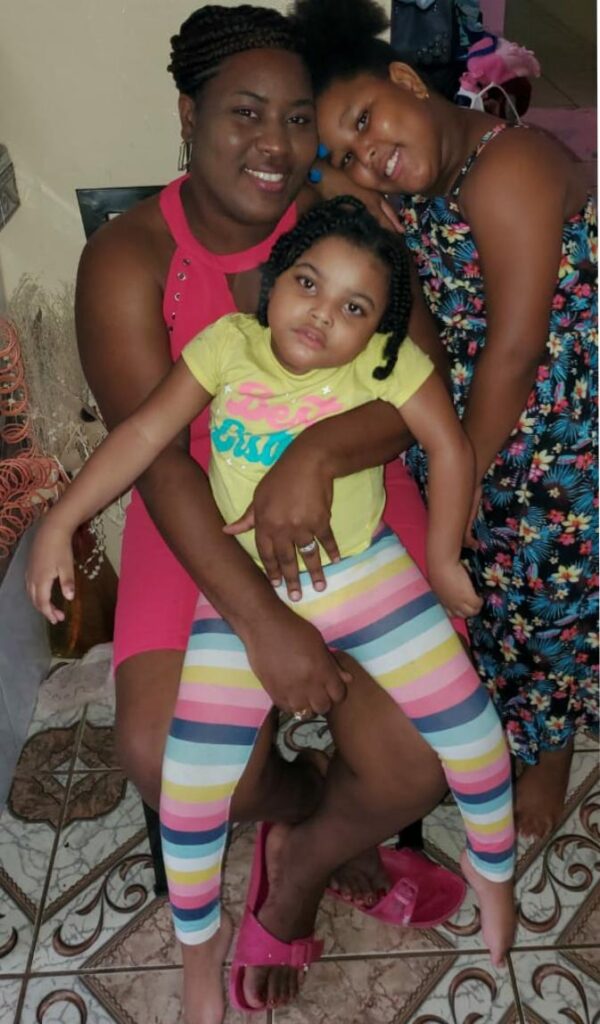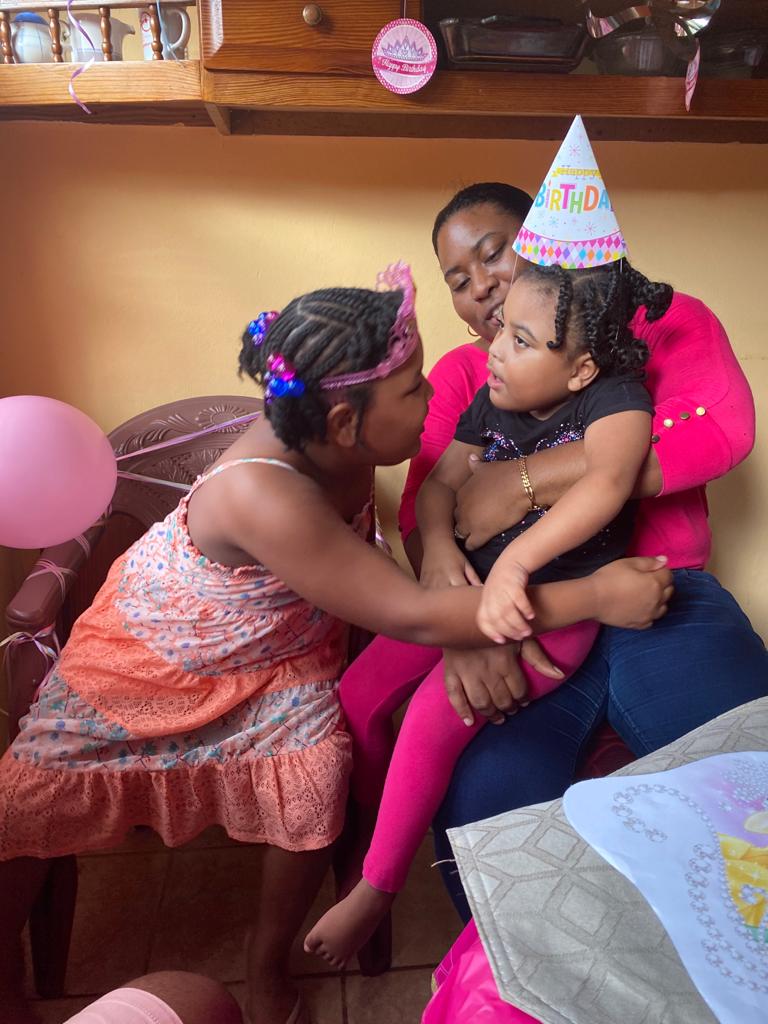
Name: Sheena David-Gill
Location: St. Andrew, Grenada
Child’s Birth Year: 2015
Keywords: Advocacy Work/Blogging, Seizures/Epilepsy, Prematurity
“Be the change you wish to see in the world.”
-Mohandas Gandhi
As a sixth-grade teacher in Grenada, Sheena had always been vaguely aware of the lack of resources for children with disabilities in her own country. Individualized education programs and learning accommodations don’t really exist. However, it wasn’t until the birth and HIE event of her second daughter, Shania, that she truly understood how large of an issue this lack of accessibility was. With her neurotypical child, Angel, Sheena never had to worry about how her daughter would interact with her peers, or if the world would be a welcoming place. But raising Shania has shown Sheena that change needs to be made.
Shania was delivered at only twenty-seven weeks. Because she was so premature and had trouble breathing on her own, she spent the next three months in an incubator. During this time, Sheena felt helpless as a mother, not knowing what was wrong with Shania—no one, not even the medical providers, truly understood what was wrong. It wasn’t until about three weeks before Shania was supposed to be discharged from the intensive care unit that Sheena physically held her for the first time. When she did, she knew there was something special about her baby girl…she was a vessel of incredible fortitude.
Unfortunately, just when Sheena thought she could finally bring her daughter home, Shania started experiencing seizures. Sheena will never forget the day she found out about the epileptic episodes. As Sheena collected Shania’s medical equipment and prepared for discharge, a nurse pulled her aside with an expression of sadness tinged with panic. When Sheena heard the words, “I am so sorry, we have some bad news,” the whole world seemed to blur. In that surreal moment, she genuinely thought Shania had died. The nurse, noticing the shock that swept over Sheena’s face, quickly clarified the situation. Shania was still alive, but she needed to remain in the hospital for longer than originally anticipated.
A flood of relief suffused over Sheena, but then the confusion, frustration, and many questions started bubbling in. Doctors had said everything would be fine, and now, three months later, there was suddenly something mysteriously wrong with Shania?
Due to her background as a teacher, Sheena was motivated to do research and find out what could potentially be causing Shania to have seizures. Upon googling anything related to seizures in infants, Sheena stumbled across the term “hypoxic ischemic encephalopathy” and saw similarities in the description of HIE and what she suspected happened during delivery. However, at first, Sheena remained skeptical, thinking there was no way that deprivation of oxygen at birth would lead to seizures almost three months later. Could the consequences of an HIE event really be so delayed? Upon joining the Hope for HIE Facebook group, she learned that seizures could, in fact, start at any time, with epilepsy not appearing in some children until the age of eight.
When Shania was finally discharged from the intensive care unit, Sheena felt completely lost as to how to best care for her daughter. She didn’t receive clear instructions, and, at the hospital Shania was at in Grenada, follow-up care didn’t really exist. After discharge, no one called to check on how Shania was doing or what had happened since—Sheena felt thrown to the wolves. Sheena considers herself fortunate because she had the support of her husband and his mother to help take care of Shania, and because their financial situation wasn’t as bad as many others in her country. In addition, because she was a teacher and had received a decent education, she was able to learn on her own through reading the literature. She cannot even imagine how parents in Grenada, who were worse off than her economically, or who didn’t have the opportunity to go to school, would survive this. Yet, it was frustrating, even for her, to have to navigate caring for a child with disabilities when resources in her country were so limited. Sheena would scroll through the HIE Facebook page and see parents posting pictures of their kids using various assistive devices, such as wheelchairs with foot straps, or wearing ankle foot orthoses (AFOs), none of which she she had access to. All she could do was adapt and repurpose what supplies they already had at home.
Furthermore, Sheena was disillusioned by the health system in Grenada after taking Shania to multiple physicians, none of whom had adequate training to deal with children with complex disabilities. Shortly after Shania’s discharge, Sheena took her to a physician known for being one of the best when it comes to advocating for children with disabilities. This physician’s daughter had Down syndrome, so Sheena thought that her personal experience would make her a more compassionate and well-informed provider. However, instead of helping, it seemed like this physician was sheltering Sheena from the truth. She told Sheena that Shania would eventually recover, without providing any explanation, and nothing the physician said aligned with what Sheena was reading online. Because Shania had been in the ICU for so long, Sheena wasn’t able to include Shania on her health insurance, so she paid for these appointments completely out-of-pocket. Sheena felt extremely betrayed, for this supposed “disability rights doctor” was wasting both her time and her finances.
Sheena decided to take Shania to a different doctor to hopefully get her daughter’s seizures under control, but even that doctor wasn’t equipped to deal with epileptic patients. Whenever Shania had episodes, the doctor panicked and sent her to the emergency room right away, instead of engaging in the treatment plan herself. After a while, Sheena felt comfortable managing Shania’s care herself with the help of anti-seizure medications.
Despite all of these challenges she has faced, Sheena is proud of the life she’s been able to provide for Shania. Shania has made tremendous progress over the years. When she was younger, swallowing was an extremely difficult task for Shania. Shania had to stop going to therapy sessions early on because the out-of-pocket costs were too taxing. Luckily, Sheena was able to practice some of the mouth movements at home with Shania. Now, Shania is able to chew and eat food by mouth.
Shania also is extremely fond of music, especially loud music from live bands. Even though it’s difficult for her to move her muscles, due to spasticity, she will sometimes gesture along to the rhythm of the songs. Shania doesn’t attend daycare or schooling, but, instead, is watched by her grandmother during the day when Sheena is at work. This was an intentional choice on Sheena’s part, since many of the daycare centers in her country have upwards of fifty children per class with minimal staff. Because one-on-one time is so important for Shania’s development, Sheena is grateful that her mother-in-law is such a supportive presence in their lives.
Angel, Shania’s older sister, sometimes becomes frustrated that Shania can’t run around with her, but she still loves Shania dearly. Angel loves tickling Shania and watching her smile, and the two sisters often watch TV together. Overall, Shania is just a very happy little girl. She isn’t burdened by the fact that she can’t walk or talk, because, to her, that is the normal she has always known.
There have been many times throughout this journey when Sheena has spiraled into thoughts of “what-if.” What if we lived in the United States, where we could have access to resources, such as therapy sessions…would Shania be walking by now? What if the doctors had realized Shania had an HIE event sooner?
To combat these thoughts, Sheena remembers that she has so much to be grateful for, and, as a parent, all she can do is give Shania the best quality of life, given their circumstances. What has kept Sheena holding onto hope these past six years has been her faith and trust in God. Sheena prays that Shania will miraculously walk one day, but, ultimately, she just hopes that her daughter continues to remain happy, even if she never reaches certain milestones. Sheena realizes, while there may be no clear-cut answer as to why the HIE event happened to Shania, as opposed to a different child, she can find her own reason and purpose. For instance, maybe she went through this experience as a mother to become more patient and flexible, both within and outside of the classroom setting. Shania has inspired qualities of grace and courage in Sheena, showing Sheena she is mentally and physically stronger than she ever thought she could be.
More than anything, Sheena has realized that, perhaps, she went through this experience so she could become a voice of change for disability rights in Grenada. In Grenada, there are rarely any ramps for wheelchairs or parking accommodations for people with disabilities. There are a few schools for children with different types of disabilities, but, after graduation, these children are abandoned and excluded from society. Adults with disabilities are left out of the workforce, so many of them sit at home all day, instead of engaging with the outside world. From some of the media coverage in Grenada, and from her experiences raising Shania, Sheena has seen the harsh reality of people with disabilities being highly stigmatized and looked down upon with scorn. For instance, she read a local newspaper article where a store owner wouldn’t let a man enter to buy groceries, simply because he was in a wheelchair. Sheena doesn’t want her daughter to grow up in a world so unaccepting of those with differences.
While she has met a few doctors along the way concerned with raising more awareness, no one has taken charge of disability advocacy work in Grenada. Sheena is motivated to initiate this much-needed movement to make life more inclusive and accessible for those with disabilities. She has witnessed firsthand the power of storytelling for social change. Through sharing her experiences and challenges of raising Shania with her coworkers, Sheena helps teachers realize that there needs to be more built-in support for students with disabilities. In addition, because today’s youth are the emerging leaders of tomorrow, it’s essential to teach them about inclusion from an early age. Sheena uses her platform as a teacher to send the message to her students that a disability doesn’t detract from a person’s worth or value. Instead, we need to all be accepting of differences, for differences are what makes the world a dynamic place.
In the future, Sheena hopes to not only be a spokesperson at her school, but to share her story with policymakers and medical providers in Grenada, in order to facilitate change at the macro level. It is through the courage of those impacted by disability to be vocal about their experiences that progress can be made, whether that progress looks like laws protecting those with disabilities from being discriminated against in the search for employment or like expanded healthcare insurance coverage for those with disabilities. Because Sheena could not find that change she wished to see in her community, she decided to be the change.


Connect with families, read inspiring stories, and get helpful resources delivered right to your inbox.